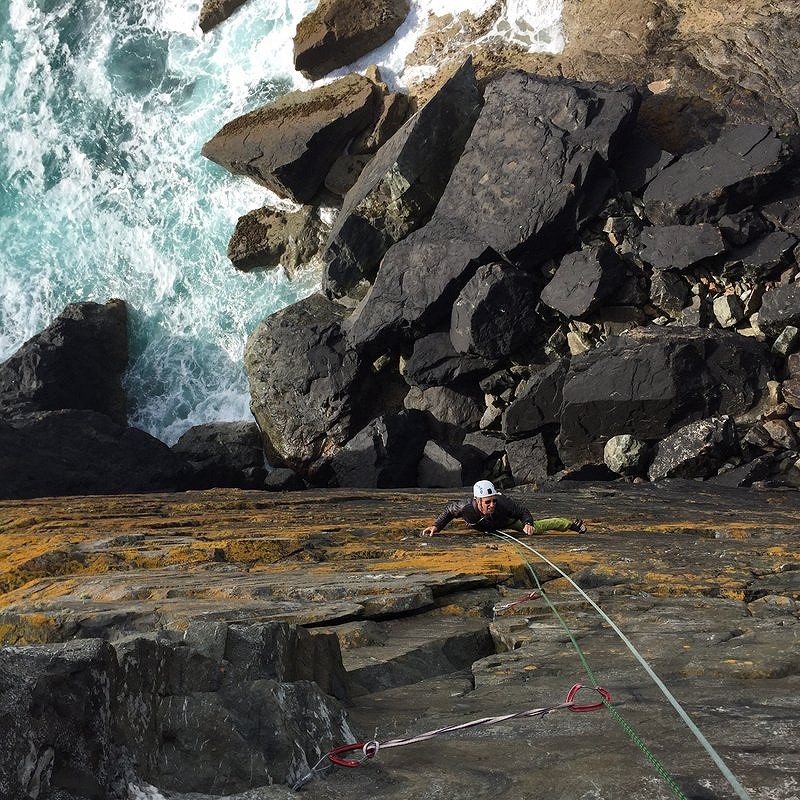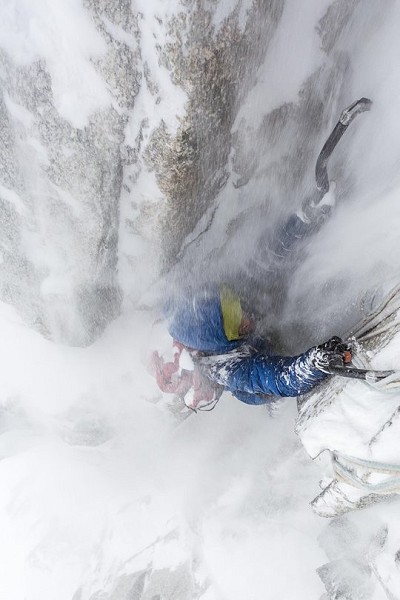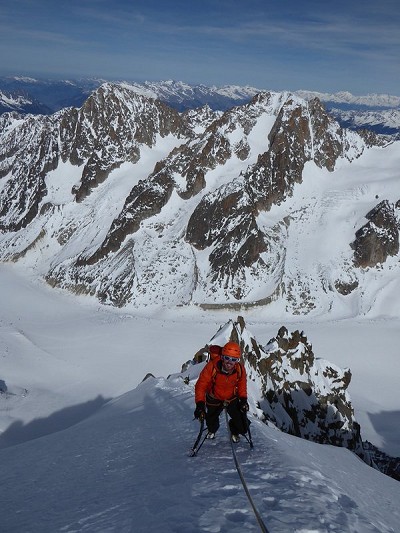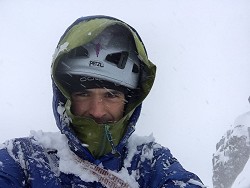
Registrant British Mountain Guide Misha Nepogodiev shares some thoughts and tips that he's learnt whilst preparing for the BMG training scheme.
The first step on the road to qualifying as a British Mountain Guide is being accepted onto the BMG training scheme. To get on the training scheme, you need to meet the 'prerequisites' for your application to be accepted and then pass the induction tests in rock climbing, Scottish winter climbing and skiing.

The prerequisites represent a solid log book of trad, Scottish winter, Alpine and ski touring experience, with minimum requirements to be met in each discipline. The prerequisites might seem daunting given the breadth of experience required but in fact they are entirely achievable for a committed mountaineer with focus and determination. Having been accepted onto the induction phase of the BMG training scheme, I thought it would be helpful to share a few thoughts and tips on gaining the prerequisites.
These are just my own thoughts based on personal experience of working through the prerequisites. Everyone's experience and background will be different, so if you're thinking about the scheme and want some specific feedback, I suggest getting in touch with the BMG. The Technical Director who is in charge of the scheme, Adrian Nelhams, is really helpful.
It's not for me to say whether this or that route or ski tour meets this or that requirement – that's a question for the BMG training committee. However, I've included some general comments which hopefully will be helpful. I've also included some practical tips on the actual application process.
Summary of the prerequisites
Details of the prerequisites are set out on the BMG website. To summarise, the technical requirements are as follows:
Trad – at least 50 multi-pitch E1 5b routes in a variety of areas. You'd want some routes on big mountain crags and big sea cliffs to show you can deal with adventurous trad.

Winter climbing – at least 50 routes at III and above, of which at least 20 must be at V or above and at least 35 must be in Scotland in a variety of areas. Realistically, you need to be solid on Vs, so will probably end up with a lot more than 20. With winter conditions being what they are these days, you will probably end up with more than 35 Scottish routes as well, though it's always great to tick off a Welsh or Lakes classic when you can! These are minimum requirements after all. Some non-UK ice routes at WI4 and above may be taken into account.
Alpine – there are a few separate requirements here:
- At least 20 major summits. There is no specific definition of a major summit but I think it's fair to say that most 4,000ers are major summits (as well as mighty 'nearly' 4,000ers such as the Eiger), whereas Aiguille du Tour probably is not (although it will probably feature in most people's logbooks!).
- 5 big TDs – at least 800m, mixed, committing, etc. Again, there is no specific definition, so best to get some specific feedback on what you've done from the BMG Technical Director. However, I think it's safe to say that something like the Walker Spur and the 1938 route on the Eiger would count.
- 5 other TDs – I think these are meant to be 'proper' Alpine TDs, not routes in the Aiguilles Rouges or on the South Face of the Midi which are given TD in some guide books.

Skiing – again, a few separate requirements here:
- General off-piste and ski touring ability in a variety of snow conditions.
- At least 30 days of ski touring experience in glaciated terrain.
- At least 15 out of the 30 days must be hut to hut tours with at least three consecutive days in huts on recognised ski tours. There is no specific definition of recognised ski tours but you can't go too wrong if you do something based on the tours in Bill O'Connor's books, recognising that there are many variations and most itineraries can be done in either direction.

Meeting the prerequisites
Here are a few thoughts and tips on meeting the prerequisites. The short version is "do lots of climbing and skiing of different styles and in different areas" but it's a bit more nuanced than that.
1. Synopsis
First of all, identify the gaps in your experience. The best way to do that is to get the application form template from the BMG website, review the various prerequisites and fill it in with your experience to date. The gaps should then be fairly obvious. You might already have a pretty good idea of the gaps but it's not until you set it out on the application form that you actually see exactly how many and what kind of routes/ski tours you still need to do to meet the minimum requirements.
The other benefit of filling in the form at an early stage is that it will save you a lot of time later. It's much easier to add to the form on a regular basis than to do it all from scratch against a looming application deadline. Even if you have a comprehensive UKC logbook, starting from scratch won't take hours – it will take days. The application form requires a lot of detail, especially for the Alpine routes and ski tours. I found it quite an enjoyable process of hunting around on UKC and in guidebooks for various missing details but it does eat up time!
2. Variety Show
I think it's fair to say that the BMG look for a broad variety of experience in each discipline, i.e. different types of routes in different areas. Don't just do all your rock climbing in North Wales and all your winter climbing in the Northern Corries. In the application form, it's a good idea to organise your list of routes for each type of climbing by climbing area as that would show the geographic areas where you lack experience. Being a Hard Rock, Extreme Rock, Cold Climbs and Chasing the Ephemeral 'puerile ticker' is pretty useful for getting you out and about!

3. El Guide Direct
This is the "British Mountain" Guide scheme - it requires a reasonable amount of experience in the British mountains in both summer and winter. I've heard of people who lived in Chamonix and had done a fair bit of ski touring and Alpine stuff but lacked British summer and/or winter experience so were asked to do more multi-pitch E1s and/or Scottish Vs.
Yet this is also the British "Mountain Guide" scheme, so you also need to have solid Alpine climbing and ski touring experience. Again, make sure it's in a variety of areas – don't just climb and ski in Chamonix, there's loads to do in Switzerland, Italy and the Ecrins. Being familiar with a wide range of areas and crags would help both with the prerequisites and with going through the scheme itself.
I think the need for broad experience covering both Britain and the Alps is actually the crux of gaining the prerequisites. If you live in Britain or Ireland, it's not that hard to get the summer and winter experience over a few years but the ski touring and big alpine routes will take many years unless you spend a few seasons in the Alps. Whereas if you live in the Alps, it's hard to get the British summer and rock experience, unless you spend some seasons back home. Even then, you might get unlucky with the weather and end up having an unproductive season…

The five big TDs are the crux for the Alpine prerequisites as you need the right combination of weather, conditions, acclimatisation and partner. These TDs need to include at least a few mixed or semi-mixed routes as opposed to just pure rock routes and it's getting increasingly difficult to find mixed routes in decent condition. There's a lot of discussion around what does or doesn't 'count' as a big TD or a big mixed TD and different people will give you different answers. I would suggest speaking with an experienced guide or the BMG Technical Director if you want specific guidance but I think it's safe to say that something like the Walker Spur and the 1938 route on the Eiger would count.
It's a good idea to include some notes in the application form about the style you did the routes in – for example, whether you bivvied on the route (not a bad thing as it shows you have experience of multi-day climbing as opposed to just 'light and fast' hits).
5. Ordinary Route
If you are a weekend warrior, don't despair. It should still be possible to gain the prerequisites, as long as you spend most of your weekends and all of your holidays climbing – it will just take a fair few years. I've been climbing for 15 years but have only seriously considered going for the BMG scheme over the last 5 years or so. By that point I already had a pretty good trad log book and a decent base for Scottish winter, alpine and ski touring but still had a fair way to go. I've managed to meet the prerequisites by being a typical weekend warrior, climbing most weekends when the weather and the conditions allowed and spending 5 or 6 weeks a year on climbing trips, mostly in the Alps. I also took an extra month off work one year which I spent in the Alps but didn't actually get that much done due to the weather!

Enjoy the process! If you don't, you probably won't get there. Don't just climb (or ski) for the log book ticks, climb because you enjoy doing it. If you don't enjoy Scottish winter climbing or big alpine routes (at least in retrospect!), you won't enjoy going through the scheme and working as a guide.
Over the last few years, I've been actively working towards filling the gaps in my experience but it's all been stuff that I've wanted to do anyway – long Scottish winter routes in the North West, Alpine north faces, classic ski tours and so on. Working towards the prerequisites simply added focus and impetus but it didn't push me to do anything I didn't want to do. If you end up doing stuff you don't enjoy, climbing just for the log book, you've got to ask yourself whether your heart is really in it.
7. Repentance Super
Don't let the log book chase get you into dodgy situations on out of condition routes. After all, part of being an experienced mountaineer is knowing when to say no. I've pulled out of plenty of Scottish winter weekends when the weather, climbing or avalanche conditions meant that it wouldn't be sensible to go out. Living in Birmingham, it's actually pretty easy to bail on a Scottish weekend trip as it saves you on a knackering drive! What's harder is saying no in the Alps, when you only have a few weeks and you really need do another couple of big TDs… but sometimes (all too often!) the weather and the conditions will dictate spending yet another couple of days in the valley.
It's a good idea to set yourself a target timeframe for gaining the prerequisites but make sure it's realistic. If the timeframe is too ambitious, you'll be more likely to push on in situations when you shouldn't. You don't want to end up halfway up an out of condition route on the Grandes Jorasses with a storm rolling in, just because you want to apply next year (or for any other reason!).
8. Absent Friends
You will need some solid partners who are psyched to do similar stuff, particularly for the bigger Scottish winter and alpine routes. There's no magic answer here but you do tend to meet people over the years. I have a few regular climbing partners for routes at the more exciting end of the spectrum and I have met them through a few different ways – UKC, the partners' book in the Chamonix mountain guides office, friends of friends in Chamonix, the Climbers' Club and my local climbing club, Solihull Mountaineering Club.
9. Technical Master
It's a good idea to have a grade or two in hand for the technical requirements. E1 and winter V isn't that big a deal these days but you do need to be absolutely solid at these grades, including in less than ideal conditions, so personally, I'd recommend solid experience at E2 5c and VI 7. You don't want to be wobbling on your induction or assessment tests! The winter induction and assessment tests may well be in Sneachda or Lochain and we all know what the V 6s there are like in less than ideal conditions! You certainly don't need to be cranking out E5s and Scottish VIIIs (though it doesn't hurt if you are!) but having a grade or two in hand is a good idea.

10. The Minimum

You can get an idea of what I've done from my UKC logbook – it's fairly complete from 2007 onwards but doesn't have some of the classic PDs and ADs which I did early on in my Alpine apprenticeship and of course, doesn't have the ski touring.
11. Mysteries
I would recommend getting in touch with the BMG Technical Director, Adrian Nelhams, who is in charge of the training scheme, well before you apply. He is very helpful and should be able to give you some feedback on your draft application (another reason to start filling in the application at an early stage). I got in touch with Adrian just over a year before applying and he gave me some pointers on what to focus on to round out my experience.
The application process
There are no interviews or practical tests at this stage (the climbing and skiing tests will be on the induction phase, once your application has been accepted). However, there are a few administrative requirements in addition to completing the actual application form.
The key point is don't leave the 'paperwork' requirements until the last moment because it can easily take a couple of months to get this sorted.
1. Savage Slit
Unless you already have a valid first aid certificate with a mountaineering component, you'll need to book onto a suitable two-day course. There are quite a few providers out there but not so many in some parts of the country and some of them get booked up weeks or even months in advance. Make sure the course meets the 'mountaineering' requirement – usually, the providers will state in the course description that it's suitable for MIA, MIC and BMG.
It's a good idea to go on one of these courses anyway because it will prove quite useful if you slip at the bottom of High Tor and end up with a nasty gash in your leg (just to be clear, practical application of first aid skills on yourself or anyone else is definitely not a prerequisite, even if it is useful experience of sorts…).
2. The Devil's Appendix
You also need a medical form from your GP. Experience with this seems to vary depending on your GP! A friend of mine simply booked a GP appointment but had to persuade the GP to sign off on the form as the GP said my friend was clearly healthy so didn't need to be certified as such! Whereas my GP surgery said I needed to leave the form with their medical secretary to pass onto the GP, who would then fill it in for me to pick up later. That didn't sound too complicated but then the medical secretary was off sick, which delayed the whole process by a couple of weeks, so I was glad I didn't leave this till the last moment.
3. The Message
You need a personal referee and a BMG referee who would act as your mentor on the scheme. If you don't know a qualified IFMGA guide who is prepared to act as a mentor, make sure you get in touch with the Training Director well in advance so that a suitable mentor could be suggested and you would then have time to get to know them. I didn't really know any guides but when I got in touch with Adrian, he was happy to suggest a mentor for me. I think it's a good idea if your personal referee is a long-standing climbing partner who can confirm at least some of your logbook, as well as attest to your general good character etc.

4. No Siesta
Unless you're still working through a few remaining prerequisites, don't leave submitting the application until just before the 31 May deadline – for your own peace of mind, send it in a couple of weeks early, or at least plan to do that and then you'll actually get it in on time after dealing with various last-minute glitches like the printer not working! There are a few things you need to submit alongside the application, like the medical form, first aid certificate, photo and application fee cheque. Bear in mind that you need to send some of this by post as well as emailing copies. This is all explained in the guidance notes for applicants on the BMG website.
5. Desolation Row
Save up some money (and then some more) because going through the scheme will not be cheap. As far as I can tell, the various courses and assessments currently cost around £10k - £11k if you pass everything first time (travel, accommodation, lift passes, replacement gear and so on are on top of that).
The other big cost is not being able to work for large parts of the year (unless you're already an ML / WML / MIA / MIC) as preparing for the assessments is a fairly full-time commitment. You'd be looking at spending May/June through to September preparing for the summer rock assessment and then December/January through to March preparing for the Scottish winter assessment. There will be travel and accommodation costs associated with that (unless you're really hard and don't mind living in a van through the Scottish winter) – all this on potentially zero income.
As far as I can tell, you can do a reasonable amount of paid work once you're an Aspirant (which is after passing the Scottish winter assessment and doing the ski touring and alpine training) but you need to fund that first year (or two years if you fail as assessment…).
Other sources of information
There have been a few UKC threads on this subject over the years. Some are more useful than others.
As mentioned above, Adrian Nelhams is really helpful and I would recommend getting in touch with him if you're seriously thinking about the scheme (it's helpful if you complete the draft application form first so he could give you specific feedback).
Finally, speak with any guides, aspirants or trainees you happen to know or come across – I'm sure most people would be happy to share a few thoughts.











Comments
Great article Misha. I particularly enjoyed the list title route names...
The second photo of me is before our sufferfest bivi, not afterwards. Can't imagine I'd have been so psyched after 12 hours of scooping spindrift out of my bivi bag!
Good effort Misha, and good luck
Ah, of course! There was a lot more snow on that ledge by the morning and we were less cheery...
You can guess the two routes I haven’t done pretty easily (well you’d know anyway).
Should be Endolphin rather than Endorphin, can’t remember now if I changed that deliberately...
Just to clarify in case anyone gets confused about the timetable, I passed the rock induction test this September after applying this May. The bio says I’m looking forward to the rock induction test because the article was originally written before then. I’m now looking forward to the ski induction test in January!
If anyone has any questions, feel free to ask here or drop me a line.
Great read, thanks for posting.